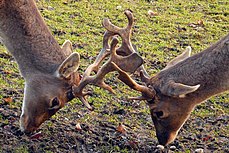| Sexual orientation |
|---|
 |
| Sexual orientations |
| Related terms |
| Research |
| Animals |
| Related topics |



Animal sexual behaviour takes many different forms, including within the same species. Common mating or reproductively motivated systems include monogamy, polygyny, polyandry, polygamy and promiscuity. Other sexual behaviour may be reproductively motivated (e.g. sex apparently due to duress or coercion and situational sexual behaviour) or non-reproductively motivated (e.g. homosexual sexual behaviour, bisexual sexual behaviour, cross-species sex, sexual arousal from objects or places, sex with dead animals, etc.).
When animal sexual behaviour is reproductively motivated, it is often termed mating or copulation; for most non-human mammals, mating and copulation occur at oestrus (the most fertile period in the mammalian female's reproductive cycle), which increases the chances of successful impregnation.[1][2] Some animal sexual behaviour involves competition, sometimes fighting, between multiple males. Females often select males for mating only if they appear strong and able to protect themselves. The male that wins a fight may also have the chance to mate with a larger number of females and will therefore pass on his genes to their offspring.[3]
Historically, it was believed that only humans and a small number of other species performed sexual acts other than for reproduction, and that animals' sexuality was instinctive and a simple "stimulus-response" behaviour. However, in addition to homosexual behaviours, a range of species masturbate and may use objects as tools to help them do so. Sexual behaviour may be tied more strongly to the establishment and maintenance of complex social bonds across a population which support its success in non-reproductive ways. Both reproductive and non-reproductive behaviours can be related to expressions of dominance over another animal or survival within a stressful situation (such as sex due to duress or coercion).
- ^ Kent, Michael (2000). Advanced biology. Oxford University Press. pp. 250–253. ISBN 978-0-19-914195-1.
- ^ Thorpe, Showick; Thorpe, Edgar (2009). General Studies Manual. Pearson Education India. p. 17. ISBN 9788131721339.
- ^ Wickler, Wolfgang; Lorenz; Konrad; Kacher, Hermann (1974). "The sexual code : the social behaviour of animals and men".
{{cite journal}}: Cite journal requires|journal=(help)